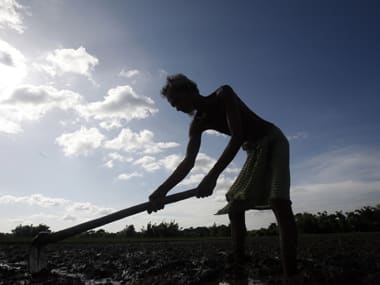A quick look at the first-cut results of the government’s socio-economic and caste census (SECC 2011) shows that that some of the populist UPA schemes like the Food Security Act and the Land Acquisition Act were too wide in their scope to be justified. The census data, released today (3 July) by Finance Minister Arun Jaitley and Rural Development Minister Rao Birendra Singh, make a good case for either scrapping or seriously modifying both laws. The Food Security Act promises two-thirds of Indian households rice, wheat and coarse grains at Rs 3, Rs 2 and Re 1 a kg. It is yet to be brought into force as many states have not finished identifying eligible households. The Act is intended to cover over 80 crore Indians (over 16 crore households), but the socio-economic census shows that that many people cannot simply be considered poor enough to be eligible. Most of it would have been money down the drain, even assuming there were no leakages. [caption id=“attachment_2325492” align=“alignleft” width=“380”]  File picture of an Indian farmer. Reuters[/caption] Here’s why. Of the 17.91 crore rural households covered, 7.05 crore households were automatically excluded from being considered socio-economically backward based on what they own or use or earn (see list at the bottom of this article). Of another lot of 10.69 crore households tentatively slotted as deprived in some form or the other, two crore households themselves reported no sense of deprivation. That left 8.69 crore households who could be considered socio-economically deprived, and hence worthy of special anti-poverty efforts or targeting. Under the Food Security Act, 75 percent of rural households would have been considered deprived and eligible for super-subsidised food supplies – about 13.4 crore households. But as the socio-economic census shows, the actual number of deprived households is 8.69 crore – more than a third less than what was proposed to be covered by the Food Security Act (FSA), Even if one were to accept that the people intended to be covered by the FSA are not the same people now considered deprived under the socio-economic census, clearly the FSA would have thrown money at people who didn’t need its benefits. The UPA scheme was clearly hopelessly irresponsible. The case for scrapping and/or modifying the Food Security Act is thus proven. Ideally, it should be scrapped. The benefits of this saving can be given to the poor identified in the socio-economic census in cash through the direct benefits transfers scheme. The FSA clearly needs to be amended in the short term to exclude hordes of the ineligible. Next, consider the Land Acquisition Act. The UPA’s version, which would make land acquisition very expensive and time-consuming, is predicated on the belief that farmers will be big losers. The socio-economic data for rural India provided by the census shows that cultivation (which could be used as a proxy for land-owning farmers) provides incomes to barely 5.39 crore households – about 30 percent of the total. Manual casual labour accounts for the overwhelming bulk of 9.16 crore households – over 51 percent. A good 14 percent – 2.5 crore households – have public or private employment. The NDA-modified Land Acquisition Act is intended to make acquisitions easier for specific purposes (industrial corridors, rural roads, homes, etc), but the fact is more than two-thirds of rural households – nearly 70 percent – do not derive major incomes from cultivation or land ownership. They will not be affected by any changes in the land acquisition act, unless the impact is directly on farm labour employment. Put another way, 70 percent of rural India needs jobs rather than land for its well-being. And these jobs will not come unless land is used for building infrastructure, homesteads, and social infrastructure like schools and hospitals. The socio-economic survey thus suggests that whatever the deleterious effects of compulsory land acquisition, its benefits may well outweigh any loss to landowners, as long as the compensation is not swallowed up by the bureaucracy or other forms of skullduggery. If the NDA can refashion the Land Acquisition Act not as a land-grab effort on behalf of the rich, but as a bid to create jobs and enhance farm incomes through higher productivity, it should develop political traction of its own. Data for urban India, which involves mapping the socio-economic status of another 7.48 million households, will be released later. Note: The criteria for exclusion in the socio-economic census (meaning, those not considered entitled for major anti-poverty efforts) included the following: (i) ownership of motorised 2/3/4 wheeler or fishing boat; (ii) mechanised 3–4 wheeler agricultural equipment; (iii) kisan credit card with credit limit of over Rs 50,000; (iv) household member who is a government employee; (v) households with non-agricultural enterprises registered with government; (vi) any member of household earning more than Rs 10,000 a month; (vii) anyone paying income tax; (viii) anyone paying professional tax; (ix) ownership of three or more rooms with pucca walls and roof; (x) ownership of a refrigerator; (xi) ownership of a landline phone; (xii) ownership of more than 2.5 acres of irrigated land with one irrigation equipment; (xiii) ownership of five acres or more of irrigated land for two or more crop seasons; and (xiv) ownership of at least 7.5 acres of land or more with at least one irrigation equipment.
The number of households considered deprived in the Socio-Economic Census of 2011 suggests that the food security law is hopelessly misdirected at a lot of ineligible non-poor.
Advertisement
End of Article
Written by R Jagannathan
R Jagannathan is the Editor-in-Chief of Firstpost. see more


)

)
)
)
)
)
)
)
)



